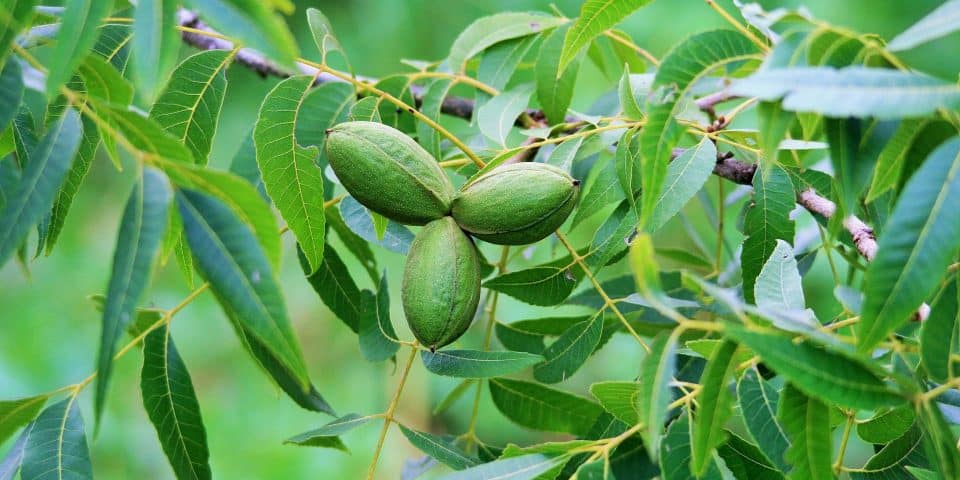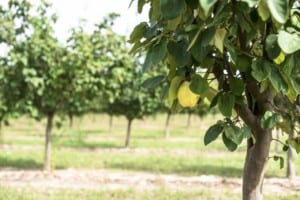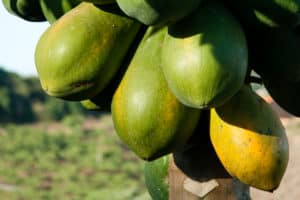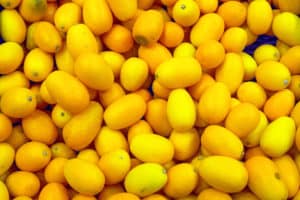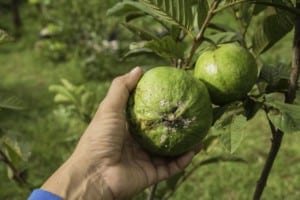Pecans are rich, meaty nuts that most people love and they can be used in a variety of dishes, most notably pecan pie. There are also many different types of pecans and each pecan tree type offers something a little different and unique to whet the buyer’s appetite.
There are roughly 500 cultivars of pecan trees and the differences are based on the size of the nut, thickness of the shell, the age at the first bearing, and the timing of the flowering, among others. There are also two main types of pecan trees that include:
- Type 1: These have male flowers that release their pollen before the female flowers are receptive to receiving the pollen.
- Type 2: These have male flowers that release their pollen after the female flowers were receptive to receiving the pollen.
Studies have shown that when you plant three or more types of pecan trees together, you get the best pollination and therefore the biggest nut types.
The size of the pecan is always taken into consideration when people attempt to find the best ones on the market. Pecan “sizes” reflect the number of nuts per pound and adhere to the following guidelines:
- Small pecans: more than 70 nuts per pound
- Medium pecans: 55 to 70 nuts per pound
- Large pecans: less than 55 nuts per pound
Bigger, meatier pecans will always be more popular and following are some of the many pecan trees currently available.
Type 1 Pecan Trees:
1. Amling Pecan Trees
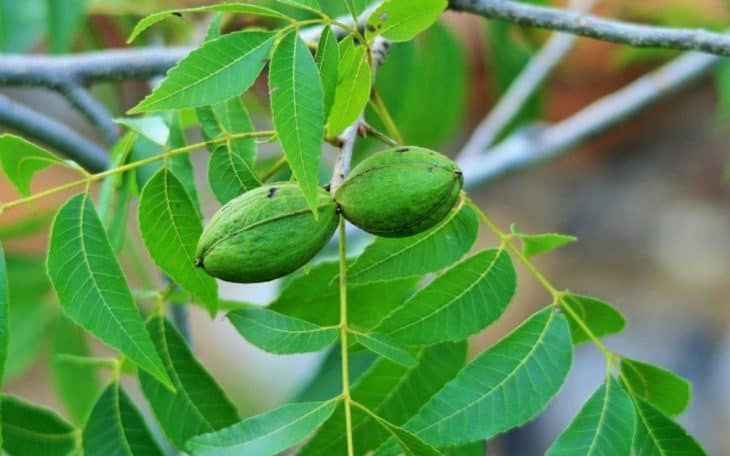
One of the most highly recommended pecan trees for home gardens, the Amling pecan tree is quite large, getting up to 100 feet in height and even 150 feet in some instances. It is therefore a great shade tree and you can harvest the nuts in September and through October.
Not only does the Amling pecan tree look great in your yard but it also provides tons of shade for you to enjoy. It is a low-maintenance tree that produces roughly 62 nuts per pound and it is scab-resistant as well. It is a very popular type of pecan tree and with good reason!
2. Caddo Pecan Trees
 Price & Details
Price & Details
The Caddo pecan tree originated in Georgia around 1922 and has a very high yield of pecans, making them very popular indeed. Perfect for growing zones 6-9, the tree produces roughly 60 nuts per pound that are also easy to peel, making them instantly enjoyable.
With sturdy branches and glossy green leaves, this is the perfect tree to plant in your front yard where it can be appreciated by passersby. Although it can take extreme heat, the Caddo pecan tree can withstand some cold temperatures as well, making it a very versatile tree.
3. Cape Fear Pecan Trees
Price & DetailsNative to North Carolina, the Cape Fear pecan tree is the one you want if you want great pecans quickly. Even as a young tree, it will produce nuts and it does so at a rate of around 58 nuts per pound. It is resistant to disease and has an elegant, shapely appearance.
The Cape Fear is a pecan tree type that will usually ripen in late October. It is perfect not just for great pecans but also for sitting under during a warm summer day. The tree can grow up to 80 feet in height and up to 40 feet wide. It does best when grown in zones 6-9.
Cape Fear pecan trees are disease- and scab-resistant and have kernels that are light in color and very attractive. It is a very sturdy and consistent producer of great pecans.
4. Creek Pecan Trees
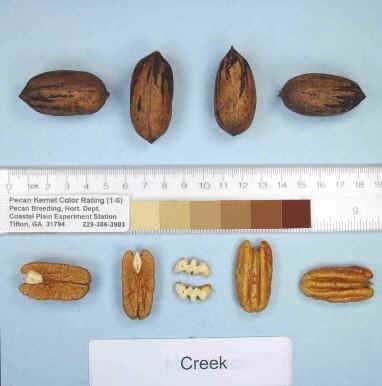
This is a very productive pecan tree that will soon have you enjoying more pecans than you know what to do with. Disease- and scab-resistant, the tree starts producing nuts in roughly five years, so you won’t have to wait long to enjoy the fruits of your labor.
Creek pecan trees produce roughly 54 nuts per pound and are super-easy to peel thanks to their thin shell, and after they start producing nuts they will make more and more each year. When it matures, it can grow up to 100 feet in height and 50 feet in width, making it a fantastic shade tree.
5. Desirable Pecan Trees
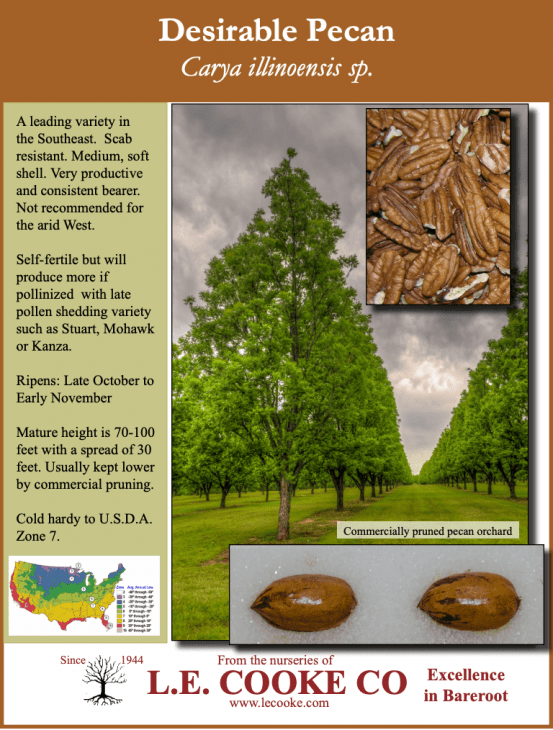
Desirable pecan trees thrive in humid climates and are therefore perfect for areas such as the southeastern part of the United States, particularly states such as Florida. They grow up to 100 feet high and usually grow two to three feet every year, making them a fast-growing tree indeed.
Not only are these pecans thick and delicious but they are produced in abundance with this tree, making them perfect for both domestic and commercial use. They grow best in areas that get a lot of sunshine and they require a Type 2 pollinator such as the Stuart or Zinner tree to produce the nuts you’ll love.
The Desirable pecan trees have soft shells and are scab- and disease-resistant, making them low-maintenance trees to grow. They usually ripen from late October to mid November.
6. Mandan Pecan Trees
Mandan pecan trees produce roughly 49 nuts per pound, making them a very productive tree indeed. They can grow up to 10 feet high and 70 feet wide so this is yet another pecan tree type that is great for enjoying shade on a hot day.
Considering that this is a northern pecan tree, the Mandan tree’s nuts are quite large and the shells of the pecans are so thin that you can enjoy them immediately after picking them off the tree. They also have strong branch angles that make them the perfect complement to the rest of your garden.
Mandan trees need a Type 2 pollinator such as the Elliot or Kanza pecan tree to produce nuts.
7. Oconee Pecan Trees
Yielding about 48 nuts per pound, the Oconee pecan tree does best in zones 6-9 and provides both easy-to-crack shells and meaty nuts that stay intact after you open them. The nuts will appear after the fifth year and the best part is that the older the tree, the more pecans are produced!
The Oconee pecan tree should be pollinated with a Type 2 tree such as the Kanza or Elliot and it grows up to 100 feet high and 70 feet wide. A low-maintenance pecan tree, the Oconee is a fairly new hybrid tree that was released in the late 1980s. It needs full sun and moist soils to grow properly.
8. Pawnee Pecan Trees
Price & DetailsPerfect for growing in zones 6-9, the Pawnee pecan tree is smaller than other types of pecan trees, growing to roughly 30 feet in height and up to 25 feet in width. It has bright green leaves and produces 56 nuts per pound, which ripen in October.
This tree is very resistant to yellow aphids and mildly scab-resistant. They are heat-tolerant and therefore perfect for growing in the Deep South. To pollinate, try matching them with Type 2 trees such as the Elliot or Sumner pecan tree. Regardless of how your landscape looks now, the Pawnee pecan tree is a great complement to it.
9. Cheyenne Pecan Tree
- Cheyenne Pecan Tree 55-60 nuts per pound
- 57-60% kernel
- Early bearer
- USDA Hardiness Zone: 6-9
- 2 years old, approximately 4-5 feet tall
10. Western Schley
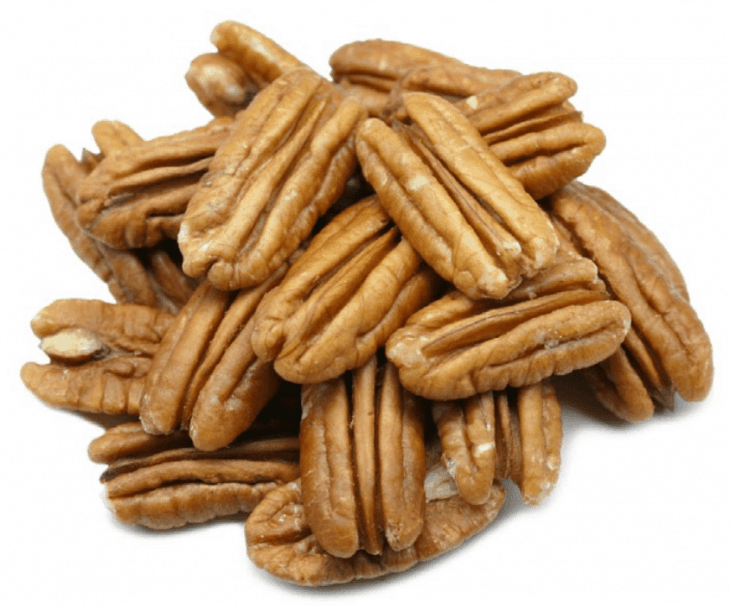
Type 2 Pecan Trees:
11. Candy Pecan Trees
Not only are Candy pecan trees gorgeous and large but they also produce great-tasting pecans that everyone will love. This type of pecan tree grows to roughly 70 feet tall and up to 50 feet in width. The reason for its name is the fact that it is often used in sweet treats.
Although the pecans are medium in size, the Candy pecan tree produces tons of them and you can use them for everything from eating right off the tree to cooking them in various dishes. As with other pecan trees, you can often purchase them online, making it fast and simple to dot your landscape with these amazing trees.
12. Elliot Pecan Trees
Known mostly for its sweet and tasty pecans, the Elliot pecan tree originated in Florida and can get up to 100 feet high and 70 feet in width. It produces 72 nuts per pound and has a teardrop-shaped shell. With the ability to grow in most of the southeastern United States, this tree produces nuts from November to February.
This is a strong and vigorous pecan tree that is scab- and disease-resistant. It requires a Type 1 pollinator such as the Caddo or Oconee tree to produce nuts. Its many positive qualities allow this pecan tree type to be perfect for both home and commercial use, even for planting in large orchards.
13. Kanza Pecan Trees
Price & DetailsIf you want a pecan tree that is cold-tolerant, disease-resistant, and a perfect shade tree on those hot summer days, the Kanza pecan tree is definitely one to consider. Because it is heat-tolerant, this type of pecan tree thrives in full sunlight and well-drained, moist soils. You can harvest the nuts in September through October.
Producing roughly 74 nuts per pound, the Kanza pecan tree can get up to 100 feet high and up to 80 feet wide. It has bright green leaves and produces meaty, tasty pecans that you will love. Since they don’t do well in extremely cold temperatures, they grow best in the southern states.
14. Kiowa Pecan Trees
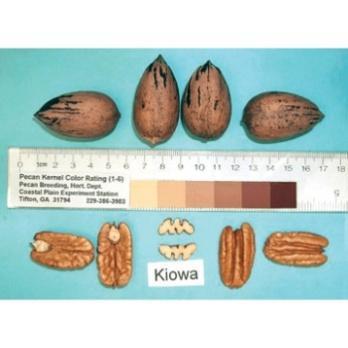
Kiowa pecan trees originated in Texas and are hybrid trees that produce 48 nuts per pound. These are meaty and tasty nuts that you’ll look forward to enjoying. Harvested in the fall, the trees start producing pecans early on and they are low-maintenance trees that require only basic care.
Best when grown in full sun and moist, well-drained soil, the Kiowa pecan tree does exceptionally well in climates found in the southeastern part of the United States. When they’re young, these trees require a lot of watering and they grow up to 100 feet tall and 70 feet wide.
These are luscious trees that produce great-tasting pecans every time.
15. Stuart Pecan Trees

This is a pecan tree type that is extremely popular in the southeastern part of the United States. Hardy and easy to grow, the Stuart pecan tree produces 50 to 55 nuts per pound that have thick shells but the nuts themselves are delicious.
Although it may take six years to start producing, the production is significant starting that year and every year afterwards.
You can harvest Stuart pecan trees in early October and as with other pecan trees, they make excellent shade trees because they grow up to 100 feet tall and 50 feet in width. They also have gorgeous leaves and need a Type 1 pollinator in order to produce nuts.
16. Sumner Pecan Trees
Price & DetailsSumner pecan trees have been around since the early 1930s and yield tons of meaty, delicious pecans. They produce roughly 52 nuts per pound and will start producing these nuts after only two to three years. The trees get up to 70 feet high and 60 feet in width and they are perfect when grown in zones 6-9.
Sumner trees are great shade trees, resist diseases, and produce easy-to-peel nuts that taste absolutely yummy. As with other types of pecan trees, they need Type 1 pollinators such as the Cape Fear or Creek pecan tree in order to produce nuts.
When the tree is young it needs lots of water but it is otherwise an easy tree to grow. The kernels are high in quality and sometimes darker in color than other pecans. They are also late-season pollinizers.
17. Zinner Pecan Trees

With beautiful green leaves and the ability to produce 44 nuts per pound, the Zinner pecan tree produces thin-shelled nuts that are easy and quick to peel and eat. They get up to 70 feet high and 50 feet wide. Because they are so easy to grow, they make a great choice even for beginning growers.
You can use a Type 1 pollinator with these trees, such as the Caddo or Cape Fear pecan tree. Because of their delicious fruit and the fact that they are so low-maintenance, Zinner pecan trees are perfect for both domestic and commercial use.
They prefer full sun and do best in growing zones 6-9, just as with many other pecan trees.
18. Forkert Pecan Trees
Price & DetailsLast update on 2024-04-25 / affiliate links / image and description from Amazon

